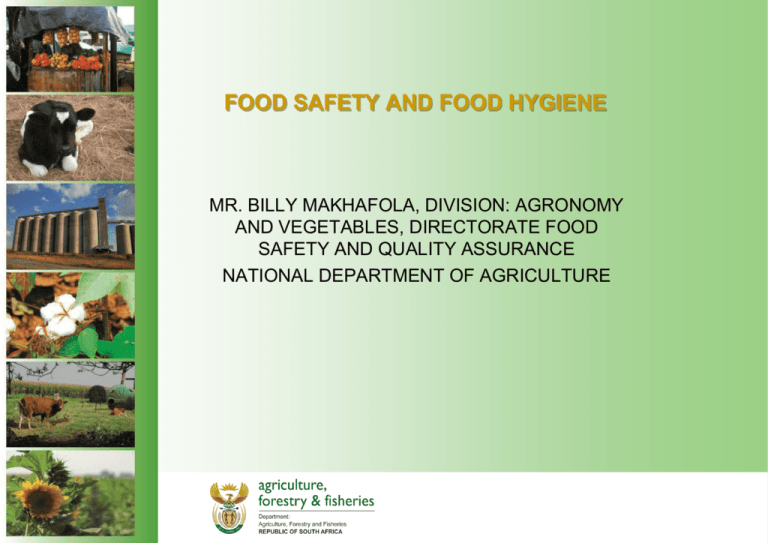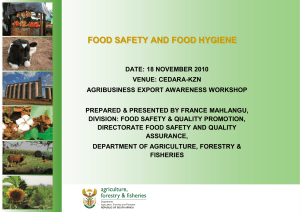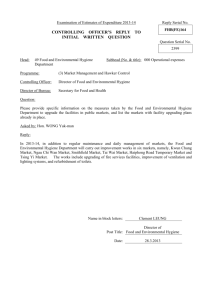An Overview of Market Access And Maintenance requirements
advertisement

FOOD SAFETY AND FOOD HYGIENE MR. BILLY MAKHAFOLA, DIVISION: AGRONOMY AND VEGETABLES, DIRECTORATE FOOD SAFETY AND QUALITY ASSURANCE NATIONAL DEPARTMENT OF AGRICULTURE ABOUT THE PRESENTATION • About the APS Act • Food safety & food hygiene standards • Scope of standards • Registration for FBO • Who should register for FBO • Impact of food safety & food hygiene standards • Benefit of compliance • Evolution of marketing standards • Towards better implementation ABOUT THE AGRICULTURAL PRODUCT STANDARD ACT, (ACT NO. 119 OF 1990) Agricultural Product Standards Act, 1990 (Act no. 119 of 1990), came into force on the 1st September 1991. Regulates the sale (local/import) and export of specific agricultural products by requiring that agricultural products: Be graded or classed according to standardized, objective, measurable minimum quality standards Be marked or labelled accordingly Packed in a certain manner. The Act was amended in 1998 in order to address: Constitutional changes (1996) • E.g. Bill of rights. International changes, e.g. ISO and Codex Alimentarius Commission. Practical needs which arose at the time, e.g. management control system (proposed Organic regulations, Food Safety standards) FOOD SAFETY AND FOOD HYGIENE STANDARDS Food Safety means “an assurance that a food product will not cause harm to the Consumer when it is prepared and eaten according to its intended use”. Standards regarding food hygiene and food safety of regulated Agricultural Food Products of plant origin intended for Export was published in line with section 4(3)(a)(i) of the APS Act. Promulgated on the 13th May 2005 Standards is only restricted to food safety and food suitability. Only cover prescribed products destined for export. Covers safety and hygiene of food products at all stages – from farm to export stage. HACCP principles have been used. Concerns itself with registration for export to specific market Record keeping and traceability. SCOPE OF THE STANDARDS These standards relate to – Food safety and food suitability, does not cover nutritional or compositional or grading matters. Food products of which the export is regulated in terms of the Act. Food products intended for export and not local sales or consumption. These standards provide for – The requirements with regard to the hygiene of food products at all stages from and including primary production up to and including the export thereof and where necessary, require the implementation of food safety programmes. The rules for drafting of guides to good practices and the application of HACCP. Scope of standards Continues …. These standards provide for - The registration for export to specific markets Record keeping and traceability and, where necessary, the withdrawal of food products unfit for human consumption. General obligation Food business operators shall ensure that at all stages of handling for which they are responsible, from and including primary production up to and including the export of food products are carried out in hygienic way in accordance with the prescribed requirements of these standards. REGISTRATION OF FOOD BUSINESSES FOR SPECIFIC DESTINATIONS Food business operators who intend to export a specific product shall ensure that all establishments under their control and covered by these standards are registered with the Executive Officer FBO shall outline the – nature of business Name and address of all premises where food business activities are carried out including particulars of the responsible person. Products /commodities (produced, packed, processed, stored and handled) Food safety and system certification received to date - for risk assessment purposes WHY IS FBO REGISTRATION IMPORTANT • To comply and maintain our international market share in term of food safety and hygiene. • It allows the identification of the origin of a product at any stage from the production unit to the final consumer. • Tracking and tracing is made possible at any point in the supply chain. Should national fresh produce market register for FBO. All national fresh produce market where regulated products are exported should be registered with the executive officer. PPECB as an Assignee of the Department will conduct food safety and food hygiene auditing. Agents who handle regulated products that are exported must also register. WHO ELSE SHOULD REGISTER FOR FBO Agri Production Unit (Farm) Packhouse (on-farm) Packhouse (off-farm) Commercial cold storage Container depot Processing plant Transport operator Sea port terminal Airport terminal/forwarde Exporter Dry storage facility Dry facility IMPACTS OF FOOD SAFETY AND FOOD HYGIENE STANDARDS Compliance fees with auditing for Food Safety and Food hygiene standards. Registration as a Food Business Operators. Training costs New investment in infrastructure (e.g. pesticides stores) Analytical test costs Water tests Mrls tests Adherence and upkeep of records Establishment of standard operating procedures for compliance purposes Establishment of traceability tools BENEFITS OF COMPLYING WITH THE LEGISLATION Achieve due diligence Facilitate international trade - Market access Automate compliance with other legislations in the industry, e.g. Act 36 of 1947, Act 54 of 1972 Ensure consistent production of safe and quality products. Maintains consumer confidence in food safety and quality Promote safe production practices for growers Minimise negative impact on the environment Food security becomes totally meaningful Encourages capacity-building EVOLUTION OF MARKETING STANDARDS AND ASSOCIATED CONFORMITY ASSESSMENT SYSTEMS FOR FRESH PRODUCE Market requirements in the 60s Quality was determined through: Visual characteristics and inspections Market requirements in the 70s and early 80s Over and above earlier requirements market requirements were based on: Quality grades, varieties (cultivar) preferences based on use and purposes. Consistency in quality and quantities EVOLUTION OF MARKETING STANDARDS AND ASSOCIATED CONFORMITY ASSESSMENT SYSTEMS FOR FRESH PRODUCE Market requirements in the late 80s and early 90s Food safety Maximum residue limits Microbiological contamination Mycotoxin (Aflatoxin) tolerances Stricter individual Country’s official import border inspection (for example the European Union). Inspection and controls by official authorities (Assignee: PPECB, PROKON in collaboration with DAFF). Requirements of the 60s, 70s and early 80s are also applicable. EVOLUTION OF MARKETING STANDARDS AND ASSOCIATED CONFORMITY ASSESSMENT SYSTEMS FOR FRESH PRODUCE Market requirements in the early 2000s: Traceability requirements: CAC/GL 60-2006: Principles for traceability/Product tracing as a tool within a Food Inspection and Certification system Regulation EC/178/2002. Strengthening of import border inspections (EU). Foreign audit inspections Food and Veterinary Organization of the EU. Codex: • Guidelines on the judgement of Equivalence of Sanitary measures associated with Food Inspection and Certification • Principles and Guidelines for the Exchange of information in Food Safety Emergency situation, etc. EVOLUTION OF MARKETING STANDARDS AND ASSOCIATED CONFORMITY ASSESSMENT SYSTEMS FOR FRESH PRODUCE Market requirements in the most recent years and going into the future: Emphasis on GAP implementation in the field HACCP in processing plants Third party certification (GLOBALGAP, BRC and ISO 22000) New, sophisticated method of sampling procedures in food business operators in order to monitor safety and quality. COMPARISON OF RSA STANDARDS TO THE CODEX AND EC Codex and EC on food safety and quality standards; RSA Standards on food safety and quality standards EC marketing standards, UNECE and Codex commodity standards on quality. Export standard and requirements, local/import regulations on grading, packing and marking requirements EC 178/2002, Codex principles and guidelines on food hygiene, traceability and food safety HACCP R908, Food safety R707, Basic Hygiene R918, metal in foodstuffs R1518 EC 1525/1998 – Contaminants in foodstuff EC MRL’s Regulation 396/2005 – 2008, Codex JMPR Good Agricultural Practices R 1145 tolerance for fungus-produced toxins in foodstuffs Export standards and requirements and the Regulations relating to maximum levels of chemical residues (Foodstuff, Cosmetics and disinfectants Act No. 54 of 1972). Act 36 and many other acts. TOWARDS BETTER IMPLEMENTATION “The focus is to have a completely different emphasis than we have had in the past. We are going to make our new priority preventing (contamination) from happening in the first place” (Joe Biden, 2009) Food safety Working Group which is co-chaired by Biden and Health and Human Service Secretary, Kathleen Sebelius. With 90 days the Working Group: New safeguards designed to cut salmonella in raw eggs, E. Coli in ground beef and other leafy greens, melons and tomatoes. A better tracking system to pinpoint the origins of outbreaks. Better communications between agencies that regulate food safety. New positions at the Food and Drug Administration and the US Department of Agriculture. TOWARDS BETTER IMPLEMENTATION The Minister of Agriculture, Forestry and Fisheries in her budget speech: 17 June 2009, highlighted the following: The DAFF will manage communicable diseases Improve on production quality to ensure enhanced food safety Finalise the strategy for food safety within 2009, To ensure a food recall system is in place for 2010 Provision of adequate, healthy and safe food for the 2010 FIFA World Cup. CONCLUSION Food safety or Food security? The life expectancy in developing countries, where food security is often seen as more important than food safety due to the high level of undernourishment in the population, is low (WHO, 2007). Why can’t we have food safety and food security?







